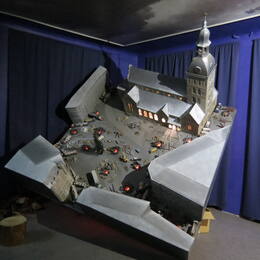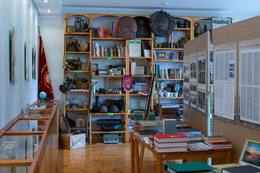Barricades
IV Soviet Occupation, Restored Independence
In January 1991, opponents of Latvia's independence attempted to stop the process of restoring independence and overthrow the legitimate power of the Republic of Latvia. To counter this aggressive behavior, barricades were built around many strategic buildings and large numbers of people were on duty. Due to widespread public involvement, opponents of independence failed to seize power. The barricades of January 1991 are an excellent example of non-violent resistance of international significance.
Through the political reforms implemented in the USSR in the second half of the 1980s, the Baltic society clearly expressed its desire to restore the independence of the Baltic States. In 1988, popular movements were established in the Baltic States (in Latvia - the Latvian People's Front or LTF), which soon announced that their main goal was to restore the independence of the Baltic States. In Latvia, the LTF won the elections held in March-April 1990, which enabled the adoption of the Declaration of Independence on May 4, 1990, with the support of more than two-thirds of the deputies. Despite the victory in the elections and the adoption of the Declaration, the central government of the USSR did not recognize the Declaration of Independence.
Despite Gorbachev's promises not to use violent methods to change power in the Baltics, Lithuania and Latvia in January 1991, the USSR army and internal affairs attacked local authorities and strategic sites. In Latvia, the aggravation of the situation reached its highest point of escalation on the 14th and 20th. January, when periodic attacks on Latvian authorities by USSR special forces fighters took place. These attacks killed civil servants and civilians. The active involvement of the public in blocking access to public administration institutions and strategic objects (barricades) disrupted the attempt to overthrow the legal power in the Republic of Latvia.
In the fight against aggressors in January 1991, non-violent resistance methods were skillfully used. At the request of the government and the LTF, barricades guarded by unarmed civilians were quickly set up around nationally important sites. Residents from all over Latvia took part in the creation of the barricades, and representatives of rural areas came with heavy agricultural, forestry and other machinery. Participants were on call and, if necessary, regularly replaced. Volunteers provided food, medical assistance points were set up, and doctors were on duty. About 40-50 thousand people took part in the barricades directly, and several hundred thousand people took part in various rallies. Barricades in each object were created based on the real situation. Both trucks, placed in a tight column, and timber were used to create the barricades around the Council of Ministers building.
Despite the fact that the Gulf War broke out in the Middle East during the barricades, events in Riga resonated around the world. Boris Yeltsin, chairman of Russia's Supreme Soviet, called on soldiers and officers not to take part in acts of violence against the people of the Baltic republic. A rally was held in Moscow on January 20, gathering around 100,000 people in support of the Baltics. The USSR recognized the independence of the Baltic states only when it had actually collapsed after the August 1991 coup in Moscow. The events of the barricades in 1991 are one of the symbols of the restoration of Latvia's independence. After the restoration of independence, extensive events commemorating the events of the barricades are being held. Barricade participants have been awarded memorials to barricade participants. The 1991 Barricade Museum has been open at Krāmu Street 3, Riga, since 2001.
More information sources
www.mk.gov.lv/simtgade/ On the way to the state of Latvia
100 events in the history of Latvia, people and processes 1918-2018. Latvian media
Related timeline
Related objects
A memorial stone commemorating the barricades of 1991
The first commemorative sign in Latvia commemorating the time of the 1991 barricades was made by Jānis Sprudzāns from Valmieri in the individual enterprise of granite products, the base was created by SIA "Grods". The author of the idea of the memorial was Valmiera police major Aleksandrs Melngārs (1954-2014), who led a group of Valmiera militiamen during the events of January 1991 in Riga. The sketches and design of the memorial sign were created by Dainis Saulītis. Opened on January 24, 2002. Initially, the memorial was placed on the corner of Rīgas and Grants streets on the land of a private owner, later in 2010 it was moved to the opposite building of the Vidzeme regional administration of the State Police.
1991 Barricades Museum
The museum is located in Old Riga near the Riga Cathedral. It was founded in 2001 to preserve historical evidence of the events of 1991 in Latvia. A virtual tour of the museum is also available. In January 1991, in Lithuania the Soviet Army opened fire on people who had gathered at the Vilnius TV tower and drove into the crowd with tanks. In response to these events a demonstration of about 500,000 people was organised in Riga to show support to Lithuanians and the readiness of the Latvian people to continue their struggles towards Latvia’s independence. In order to prevent similar events from happening in Latvia, residents began to build barricades in the narrow streets of Old Riga in order to prevent possible attacks of the Soviet Army on the defenders of the barricades. These barricades were also created at various strategic objects not only in Riga, but throughout all of Latvia. Around 50,000 people from all over Latvia participated in defending the barricades. Barricades was a popular movement that helped to regain Latvia’s independence. This is a great example of non-violent resistance in the history of the whole world.
Permanent exposition of local history of Vaidava parish
Located in Vaidava Culture and Craft Center.
There is an exposition dedicated to the memory of the deportations of 1949, as well as the participation of the people of Riga in the January 1991 barricades in Riga. Evidence of world wars (mainly printed materials) can also be seen in the exhibition.
Natural and historical objects, manors, history of education, culture, notable people, materials of the collective farm time, household items, banknotes, newspapers, magazines about Vaidava parish.
Related stories
Vaidavians on barricades
In 2020, in anticipation of the 30th anniversary of the 1991 barricades, Vismants Priedīte shares a story about the participation of locals in these historical events.
Memoirs of Talava Megnis from Kocēni about the events in the 1991 barricades in Riga
Memoirs of Talava Megnis from Kocēni about the events in the 1991 barricades in Riga.
"On January 13, about 40 residents of Kocēni left Laz, driver Vitālijs Sprukts and minibus Latvija, driver Jānis Grava for the demonstration in Riga.
After the demonstration, when we met at the buses, we repeatedly heard on the radio the call of the Latvian People's Front, those who can, to stay in Riga and defend strategically important objects to make it more difficult to capture them, similarly to Vilnius television. We saw these footage filmed by Podnieks before leaving for Riga.
From Rezekne to the 1991 barricades
The narrators describe the moods and personal experiences of the Barricade period. Memories illustrate well how information can reach the people of Latvia throughout its territory.




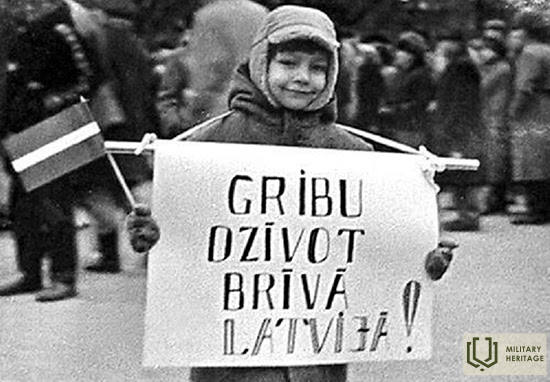
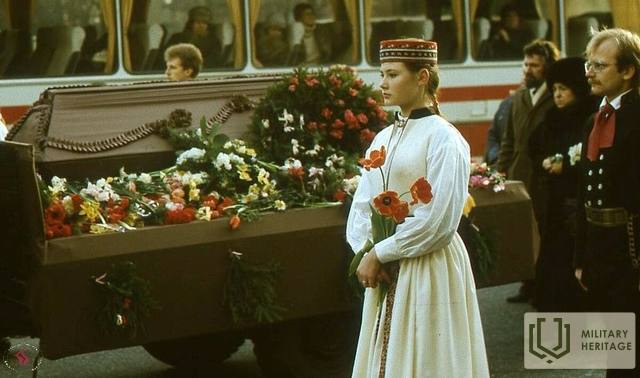
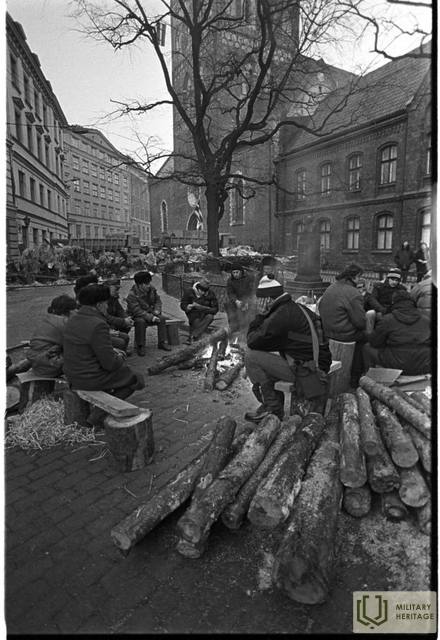
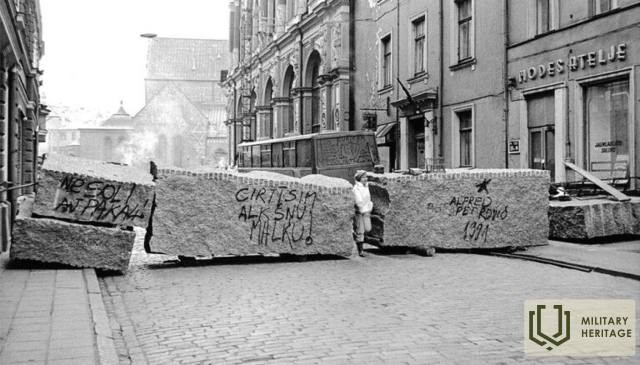
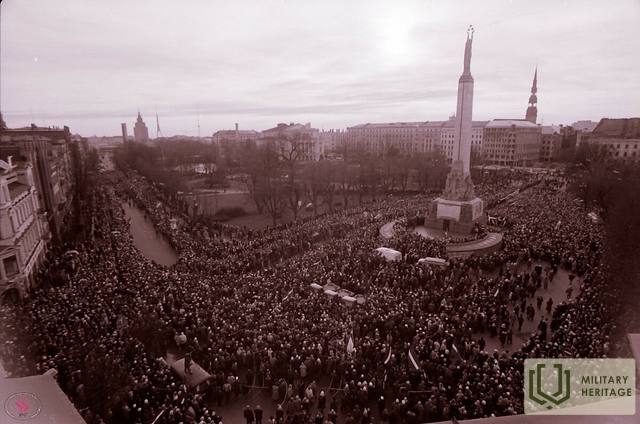


![1991. gada barikāžu atceres piemiņas akmens Rīgas ielā Valmierā. Avots: Valmiera [ilustrēts izdevums], izdevusi apgāds Jumava, 2008. - 87.lpp. Autors Nils Smelteris.](/g/Poi/00540/Dzelzcela-tilts-Valmiera_1922g2.jpg?size=260)
